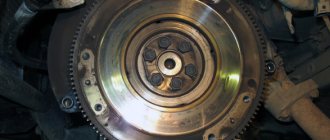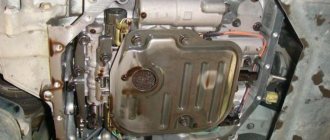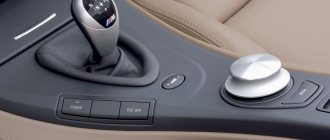As a result of the constant stress to which the manual transmission and clutch are subjected, most drivers are increasingly beginning to notice problems with shifting gears.
However, not everyone has time to respond to them in a timely manner, because often the only sign of a manual transmission malfunction is not fully engaging the gears or starting them with a slight stretch. Therefore, in order to avoid serious problems in the future, you should very carefully monitor such manifestations and promptly eliminate the cause that provoked their occurrence. It is better to immediately seek help from a car service center, for example, if you are from St. Petersburg, then here https://spb-avtoremont.ru/p264438239-remont-kpp-mkpp.html.
Finding the reason
The easiest way to determine why manual transmission gears do not engage is in two ways:
1. Stop the engine and turn up the speed - If nothing happens, then the problem is most likely due to faulty synchronizers or gears. To determine the culprit of the breakdown, the manual transmission will have to be disassembled.
2. Start the engine and put the car in gear - If it doesn't work, the problem is in the clutch. Most often, this malfunction is caused by problems such as insufficient lubrication, incomplete engagement of the clutch and lack of fluid in the drive hydraulic system. Moreover, the last malfunction is typical only for cars equipped with a hydraulic clutch.
In any case, in order to determine the true cause, you will have to remove the manual transmission and inspect the condition in which the clutch basket is located; if it is satisfactory, check the volume of fluid that is in the expansion tank and if it is insufficient, top up.
The main causes of manual transmission malfunctions
Manual transmission diagram
In good condition, a car with a manual transmission accelerates quickly and without jerking. It is worth highlighting the symptoms that a malfunction of the gearbox on the car has occurred:
- one or more gears do not engage;
- changing speeds is difficult;
- “knocks out” the transmission, extraneous noise is heard;
- the appearance of oil smudges under vehicles.
The range of occurrence of these manifestations is quite wide, ranging from gear wear to the use of low-quality gear oil. As a rule, a problem with shaft bearings occurs if vehicles have been in operation for a long time. If they are worn out, noise may occur at idle.
If there is no lubrication on the bearing or there are cracks on the rollers, a whistle may be heard.
The clutch includes a disc and a basket. Malfunctions of the basket may be associated with wear of the “petals”, as a result of which it will overheat, which will affect the efficiency of changing speeds. Gears often fail to shift because the friction linings of the disc have become deformed. Against this background, a drop in power indicators may be observed.
In case of any manifestations, you cannot do without diagnosing the car transmission. This procedure should be entrusted to car service specialists. In some cases, repair work may involve replacing the transmission fluid. Adding new fuel to the existing old one is allowed, but you should use fuel of the same brand that was previously added. Otherwise, mixing liquids of different brands will negatively affect the functioning of the vehicle.
Insufficient lubrication
Despite the fact that if there is a lack of lubrication in a manual transmission, the gears are still engaged, shifting them can be quite difficult, since the gears cannot fully engage with each other. In addition, insufficient lubrication can even damage synchronizers over time.
Therefore, if you hear an unpleasant metallic grinding noise when changing gears, check the oil level in the manual transmission and inspect it for leaks. If any are present, replace all gaskets and seals. It would not be a bad idea to also change the oil seals located in the shank and on the input shaft.
Why is it difficult to engage manual transmission gears?
Gear shifting problems
on mechanics most often arise for the following reasons:
- The most common problem is clutch failure. In such a situation, reverse gear turns on with a bang. This happens because the gear overlaps the tooth. Reverse speed is the only gear in the box that does not have synchronizers. For this reason, clutch failure is so obvious on it.
- The second reason is a defect in the mechanism responsible for selecting the gear. This breakdown occurs when the car is stationary and you try to shift into gear.
- The third is severe wear of the gearbox synchronizers. Mostly, breakdowns occur with those that are most often used. These are first, second and third gear. Severe wear of the synchronizers only appears when switching while driving.
To prevent possible gearbox malfunctions, perform regular maintenance, change the oil on time, and in case of minor failures, rush to diagnostics
. This will save you time and money in the future.
Watch the video for what not to do with a manual transmission:
Main problems and their solutions
If the previous checking methods did not yield anything and the malfunction that caused problems with shifting gears on the manual transmission is not determined, then you need to inspect the condition in which the clutch basket is located. The main impetus for this should be the fact that the gears stop shifting when the engine is running.
First of all, inspect:
• Release bearing – When in normal condition, its movement along the input shaft should not be hindered in any way. If it starts to jam in some places and it moves along them with difficulty, then this is the reason. However, do not worry, as it can be solved by simply replacing the problematic part.
• Disc wear – To determine how badly it has worn, disassemble the basket and visually assess its condition. There should be no carbon deposits on the friction linings, and the rivets under the disc should not be visible. If one of these problems is present, the disk will need to be replaced. Most likely, after this procedure the problem with switching gears will be solved.
• Malfunction of the basket itself – During long-term use of the car, the so-called “petals” that make up the basket wear out greatly, as a result of which they become very susceptible to high temperatures and can no longer cope with the removal of the pressure disk. Often, to determine the condition in which the petals are located, a simple visual inspection is sufficient - its petals will be deformed or show signs of overheating. In this case, the basket will have to be replaced.
• Hydraulic booster – If there is not enough fluid in the system or there is air in it, the gears on the manual transmission may periodically not turn on. To diagnose, inspect the reservoir and inspect all drive components, including hoses, tubes and release cylinder. All identified areas with leaks will need to be repaired and the system pumped.
Manual transmission: What you need to know when shifting gears
The result is premature wear of the clutch disc. In order to keep the car from rolling on an incline, you need to depress the brake pedal. In order to start, of course, you will have to press the clutch and smoothly press the gas, releasing the clutch. In this case, you will reduce the load time on the clutch basket and release bearing. You can also hold the car by maintaining certain engine speeds, catching a certain moment when you release the clutch and press the gas.
We recommend: DIY car window tinting
Surprised? But in fact, this advice is really very important, because having a habit of leaving your hand on the gear shift knob can lead to premature transmission failure. If you most often leave your hand on the gearbox when stopped in a traffic jam or at a traffic light, then the first gear of the manual transmission suffers the most. Remember that by placing your hand on the gearshift knob, you create extra pressure on it, which is transferred to the gearbox. As a result, excess pressure on the handle can lead to unfree shifting of the desired gear. This can damage the gear shift knob as well as the transmission itself.
Clutch assembly
If in order to detect a problem with gear shifting you had to disassemble the clutch, be extremely careful when reassembling it. Tighten all threaded connections with extreme care. And be sure to center the clutch before installing the manual transmission. For this purpose, you can use either a special tool or the input shaft, which will have to be removed from the old gearbox.
WE RECOMMEND ALSO READ:
If you have a mechanic
Gears shift poorly in a car with a manual transmission for three reasons. The first of these is a malfunction of the clutch when it does not completely disengage (drive). The first sign of this malfunction is that the reverse gear is engaged with a characteristic crash. The rear one reacts to this anomaly more noticeably than other gears, because it is the only one not equipped with a synchronizer.
The second reason is a defect in the gear selection mechanism of the gearbox. And finally, the third is excessive wear of the gearbox synchronizers.
There are also several clutch malfunctions in which manual transmission gears shift poorly:
- Air in the clutch release hydraulic drive or fluid leakage from it. The malfunction is eliminated by replacing failed components of the hydraulic system and pumping it.
- Worn or broken clutch release fork. The part requires replacement or repair.
- Warping (runout greater than 0.5 mm) or too thick new driven disk.
- Failure of the basket (temperature deformation of the pressure plate or its distortion).
- Loss of mobility of the support bearing of the gearbox input shaft (at the end of the crankshaft to which the flywheel is attached).
- Jamming of the clutch driven disc hub on the splines of the gearbox input shaft. To eliminate the defect, clean the splines of the gearbox hub and input shaft. It wouldn’t hurt to lubricate them a little with lithol.
There is too much free play in the clutch release fork. Its value needs to be clarified with the manufacturer, since it is slightly different for different cars. Until you find out the value of this parameter for your car, set it from 5 to 8 mm. Too little free play of the fork is also undesirable, as it leads to clutch slipping and increased wear of the release bearing.
Excessive wear of synchronizers mainly occurs in those gears that are engaged more often: these are usually first, second and third. The rear one is not included in this list because it does not have a synchronizer. When your gear shifts poorly, and you assume that the reason for this is wear of the synchronizers, firstly, you should only have difficulties with this while driving. Secondly, in this case it switches better if you use double squeeze.
For those who don’t know what double squeeze is. To shift to a higher gear: depress the clutch, engage neutral, release and depress the clutch again, engage the gear.
Backlash in the so-called “helicopter” is one of the reasons for unclear gear shifting
To switch to a lower gear: double squeezing must be combined with re-engaging, that is, when the clutch pedal is released and the gearbox is in neutral, you need to press and release the accelerator pedal. This is how gears are changed in cars that do not have synchronizers. If the gearbox shifts easier using double squeezing, then the culprit for poor gear shifting is most likely worn synchronizers.
If the gears shift poorly when the car is standing still with the engine turned off, the fault may only be in the gear selection mechanism of the gearbox.
Look for damage or check that it is adjusted correctly. Don't even think about the clutch and synchronizers.
How to extend service life
The longevity of a manual transmission depends on how you operate and maintain it. Nowadays there are actually a lot of myths circulating that you don’t need to take care of the mechanics, and that they work for the entire life of the car, this is not entirely true.
- The most important thing is smooth gear shifting, with the clutch pedal fully depressed. It is NOT ALLOWED for the pedal to be pressed only halfway or not at all! This leads to premature wear of gears and synchronizers.
- After the desired shift has occurred, you need to release the clutch pedal, there is no need to hold it! Because there is increased wear on the clutch disc
- It is advisable to move in the gear that corresponds to a given speed, this relieves both the engine and the gearbox from unnecessary loads, the best is 4th gear, also called “direct”, in this connection the minimum number of gears and all two shafts are occupied (in bypassing the intermediate). This reduces wear on the manual transmission
- A lower gear should be engaged when the speed decreases, just like an upshift when accelerating. This reduces the load on the engine and the transmission itself
- There is the “first” one that didn’t turn on right away (there was a crunching sound), this happens even on new cars, you shouldn’t push the lever all the way! You need to release the lever and clutch pedal, and repeat the procedure after a few seconds (sometimes you need to press the clutch pedal twice)
- Do not engage reverse gear while moving forward. Of course, now all modern cars have “foolproof protection” (you simply won’t turn it on), but on older cars such a switch could immediately lead to a breakdown
Separately, I would like to say about transmission fluids in manual transmissions, as I wrote above, now many are sure that there is no need to look at the lubricant inside, and that it is filled for the entire service life, this is not so:
- At least once a year, inspect the manual transmission (especially after aggressive, off-road driving) for oil leaks. Often, both the filler neck itself and the seals can leak; this must be eliminated at an early stage to prevent the level from decreasing
- The oil level is checked every 15,000 kilometers; if it drops, you need to top it up
- Complete replacement after 60 - 70,000 kilometers, it also wears out, like in an automatic machine. However, you don't need much of it
- Use only transmission oils specified by the manufacturer; other tolerances may thicken excessively in the cold and also negatively affect the seals. Do not mix with other compounds as this may cause excessive wear.
Here, lubrication also plays an important role: it protects, lubricates and preserves.
Now we are watching the video version of the article
I’ll end here, I think my article was useful to you, sincerely yours, AUTOBLOGGER
Similar news
- The automatic transmission stalls and kicks slightly. Why and what's going on...
- Hardware or partial oil change in automatic transmission. How to do it right...
- Automatic transmission adaptation reset. We will consider KIA and Hyundai










